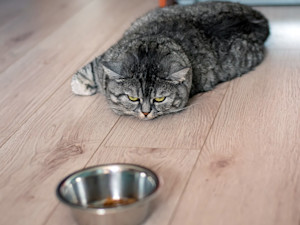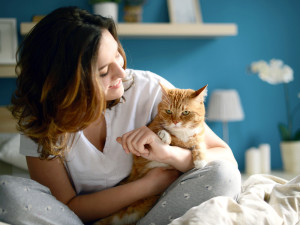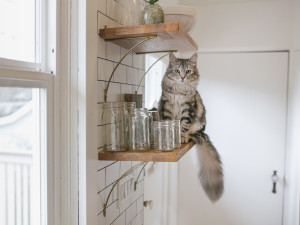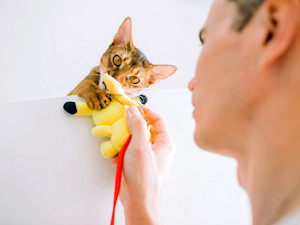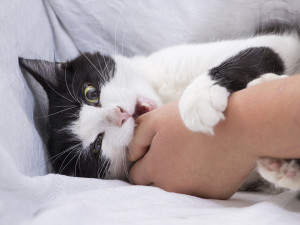How to Train Your Cat to Behave At Your Dinner Parties
That small plates feast you’ve cooked is meant to impress your pals, not your thieving kitty
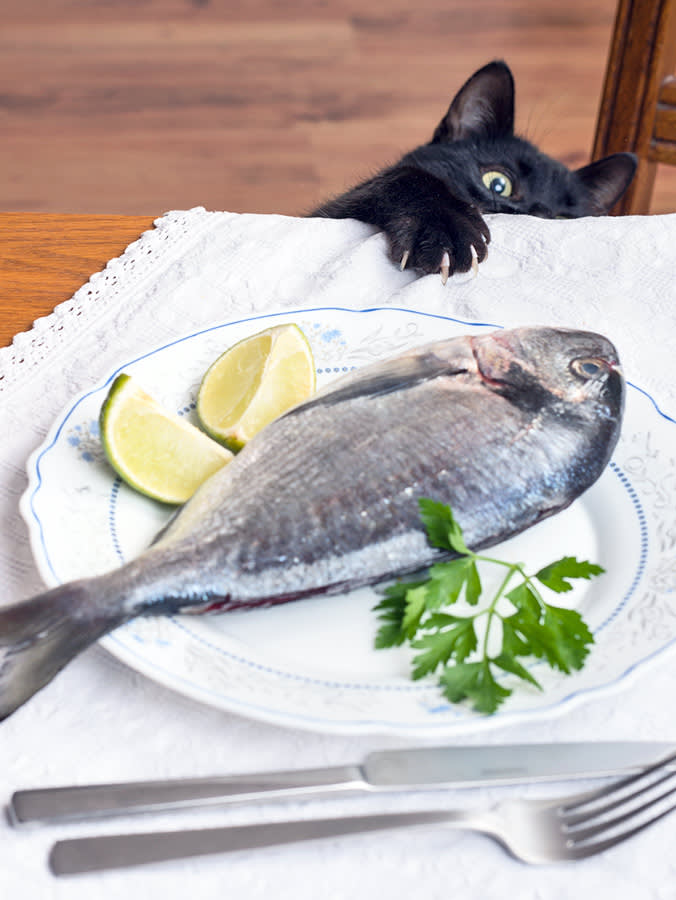
Share Article
Picture this: you and your favourite feline are at home alone (because you’re a childless cat lady and proud), you’ve whipped up a tasty meal to enjoy in front of the latest episode of Love Is Blind and your cat jumps up on to the table to watch with you/have a sniff of your plate.
Obviously you’re not going to give them any food directly from your plate. Because obviously you know that would be a really foolish thing to do because then you’re letting your cat know they’re welcome to eat human food – and obviously you’re no fool. But then your feline employs their most dangerous weapon – the pleading eyes – and it’s all over. They trot off with their tasty morsel and you tell yourself that it won’t happen again, it’s cat food only from now on!
Until next time…
As pet parents we are often guilty of bending the rules with our animals, particularly when no one is watching, but what happens when someone is watching? Imagine the previous scenario again but this time you have company and your cat jumps up on the dining table mid-meal and starts demanding food from your guests. Quelle horreur!
So, the question is, can you train your cat to behave when you have company or untrain bad habits such as food thievery, nipping or scratching your guests, or jumping up where they shouldn’t? We speak to a cat behaviourist to find out.
Should you be feeding your cat human food in the first place?
Before we get into cat etiquette, let’s talk about whether it’s safe to give your cat treats from your plate. When it comes to sharing your food with your cat, it’s always important to double-check that what you are offering is safe for your feline friend. There are some foods that are OK in moderation, but there are also some foods we eat all the time that are surprisingly toxic to cats. If in doubt, consult your vet before offering your cat something new. Always make sure that what you offer is free of spices and oils that could be problematic for your cat, even if the main ingredient is safe.
Be sure to avoid foods that may be a choking hazard or cause injuries to your cat’s digestive tract, such as foods with bones, shells, toothpicks or skewers. And finally, remember that cats have very unique nutritional requirements so they should get the bulk of their diet from a balanced cat food diet. Treats may be delicious, but they should only make up about 10 percent of your cat’s total diet.
Can you actually train a cat?
“While most cats can’t be trained to the same level as dogs, it is possible for your cat to learn how to behave,” says trainee animal behaviourist Lottie Phillips. And before you jump to conclusions, this isn’t because dogs are smarter than cats, it’s all down to motivation. “Cats are often motivated by different incentives; they respond well to positive reinforcement, such as treats or play, but they’re less likely to be motivated by a desire to please their human,” she explains. Some cats can even be trained to do tricks, like high-fiving or ‘sit’, which clicker training can be really useful for.
It starts with communication
“Understanding cat body language is really important when it comes to training cats or redirecting unwanted behaviour,” explains Lottie. It’s crucial to learn their communication cues, such as tail movementsopens in new tab, ear positions and vocalisationsopens in new tab. For instance, some cats will meow or trill in greeting, or they might growl, snarl, spit or hiss as a way to tell humans or other cats to back off.
“A friendly, confident cat holds their tail high with ears perked forwards,” says Lottie, but if your cat averts their eyes or if they tuck their tail in under their body, it can be a sign that they feel uncomfortable or even threatened. “Aggressive behaviour can manifest as ears flattened against their head, a lashing tail, bristling fur, trying to make themselves appear larger, and an arched back,” explains Lottie. While “slow blinking is a sign that they feel comfortable and safe around you,” she says. Understanding all these subtle signs is the first step to training your cat not to commit any social faux pas at dinner.
Lottie goes on to explain that pet parents need to employ the following tools when trying to train their felines.
Patience
“Cats follow their own rules and timelines, so training a cat not to do a behaviour, like jumping up where you don’t want them to, will take time.”
Rewards
“Cats need a good reason to follow your instructions, and treats are perfect motivators,” says Lottie. “But if you’re trying to train them not to eat human food, then only use cat treats for this!” Remember, moderation is key – you don’t want to overfeed your cat.
Consistency
Unfortunately, you can’t have it both ways: letting your cat do things in private that you wouldn’t want them to do in front of your guests, and then expecting them not to behave in the same way on a different day. “If you’re serious about teaching your cat a behaviour, then you absolutely have to stick to that rule 24/7,” says Lottie.
How to stop your cat from doing a specific behaviour
“Starting to train your cat as a kitten is typically easier as you can discourage bad behaviour from the start, but if you have to start introducing new rules to an adult cat, it can still be done,” says Lottie. You should always avoid punishing your cat for doing something you don’t want them to, never use a spray bottle, and of course it should go without saying that you should never physically harm your cat as a punishment.
To curb unwanted behaviours, the best way to start is by thinking like a cat: “Try to understand what they are getting out of the undesired behaviour,” says Lottie.
Begging for food
When your cat tries to steal or beg for food, you can shoo them off, but to get them to stop doing it, you need to drill down to the ‘why’. “On the one hand, it’s a learnt behaviour because they’ve succeeded before when you’ve fed them food off your plate, and on the other hand, it could just be because they want food,” says Lottie.
“Start getting into the habit of feeding your cat their meals at the same time you eat yours to create a routine and help them associate you eating dinner with them eating dinner,” suggests Lottie. If you start doing this consistently, then by the time you have people over, your cat should hopefully know not to associate human mealtime with a chance to receive human food. This also works as a distraction: if they’re eating, they won’t be bothering you or your guests and will probably just want to relax into a food coma afterwards.
Lottie cautions that if you currently feed your cat their last meal of the day at 5pm, for instance, but you don’t eat dinner till 8pm, you will need to change their feeding time very gradually rather than a drastic change all at once.
“If a main meal isn’t enough of a distraction technique for your cat, try putting treats in puzzle feeders to keep them busy,” says Lottie.
Jumping up on the table
Cats love to be in high placesopens in new tab where they can survey their kingdom and feel safe, which could be the reason behind your cat’s desire to jump up there. Yes, you can pick your cat up and put them on the floor every time they jump up, “but this could feel like a game to them”, explains Lottie. Instead, redirect them to new more appealing spots. Lottie suggests investing in cat perches and cat trees. If you want to save money and/or space, you can simply screw some wooden perches to the wall and create a network of spots for them to explore and relax on. It might take some time for them to make the transition but, as the saying goes, ‘if you build it, they will come’.
Biting or scratching
Cats who have a lot of energy and a strong prey drive sometimes attack ankles and feet, which is not ideal when you’re welcoming visitors into your home. So help your cat get out their excess energy by engaging in playtime before your guests arrive. “Play with a wand toy to help them expend their prey instincts and tire them out so they retire to a cosy spot to sleep before anyone gets there,” says Lottie.
Some cats also experience petting aggressionopens in new tab, which “occurs when a cat lashes out in response to being touched, usually moments after they seemed to enjoy it”, explains Lottie. If your friends want to stroke your cat, make sure they know where your cat likes to be touched. Most cats prefer to be stroked on the back of their neck, on the chin or cheeks, and behind the ears – but never on their sensitive belly – and they generally prefer small massaging and kneading movements over long stroking. “Tell your guests to let your cat approach them first and sniff them out before attempting any contact,” advises Lottie.
Fearful or stressed behaviour
Biting, scratching, hissing, hiding or erratic behaviour are also common signs that your cat is stressed (remember what we said about learning their communication cues). Cats are super sensitive to changes in their environment and can become anxious quite easily.
Some cats, particularly rescues or cats who haven’t been socialised as much with humans, might feel very uneasy about strangers entering their territory, especially if there’s suddenly lots of commotion, noise and new smells. “Always make sure your cat has a safe space to retreat to,” says Lottie. “Let them take refuge in a bedroom or even head outside to get away from the hectic atmosphere if they’re an outdoor cat.” Lottie also says unless your cat is very chill and used to being picked up and carried around, you shouldn’t pick them up and try and force them to interact with your guests. “Let them do everything at their own pace and this will help ensure a great evening for both feline and humans!”

Ro Elfberg
Ro previously served as Kinship’s Senior Editor. Now a freelancer, she has written and copy-edited for British Vogue, Glamour, DICE and of course, Kinship. When she’s not being manipulated into dishing out Dreamies to Kobe the cat, she spends her free time trying to convince her snake, Butters, to wear a tiny hat.
Related articles
![Woman trying to hug a grumpy orange cat.]()
People Are Bad at Knowing When Their Cats Are Annoyed, Study Says
We can tell when cats are happy, but we’re pretty bad at figuring out when they’re not
![A cat sitting on a shelf with glassware.]()
Why Do Cats Knock Stuff Over?
Your brand new iPhone, antique figurine, full glass of water – they will swat it off the table. A cat behaviourist explains why
![cat playing with pikachu toy]()
Happy Cat, Happy Life: 5 Enrichment Tips to Keep Your Kitty Content
What is enrichment and why is it so important to keep your kitty happy?
How Does Your Cat Choose Which Lap to Sit On (and Why Isn’t it Yours)?
Hiding treats in your pockets out of sheer desperation? Learn how to make your thighs the Chosen Ones
![cat biting person's hand]()
Why Did My Cat Bite Me?
Don’t live in fear of your feline overlord. A vet explains why cats bite (and what you can do to avoid their wrath)




